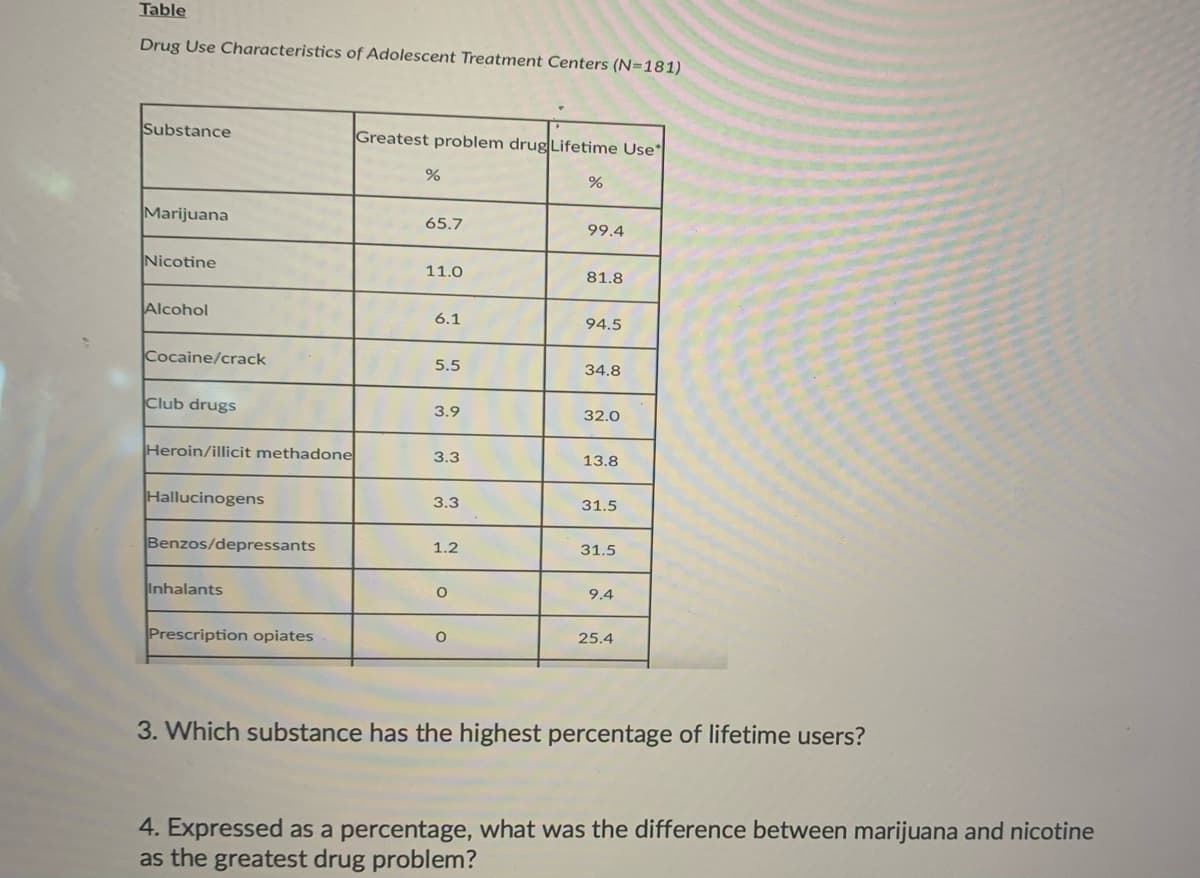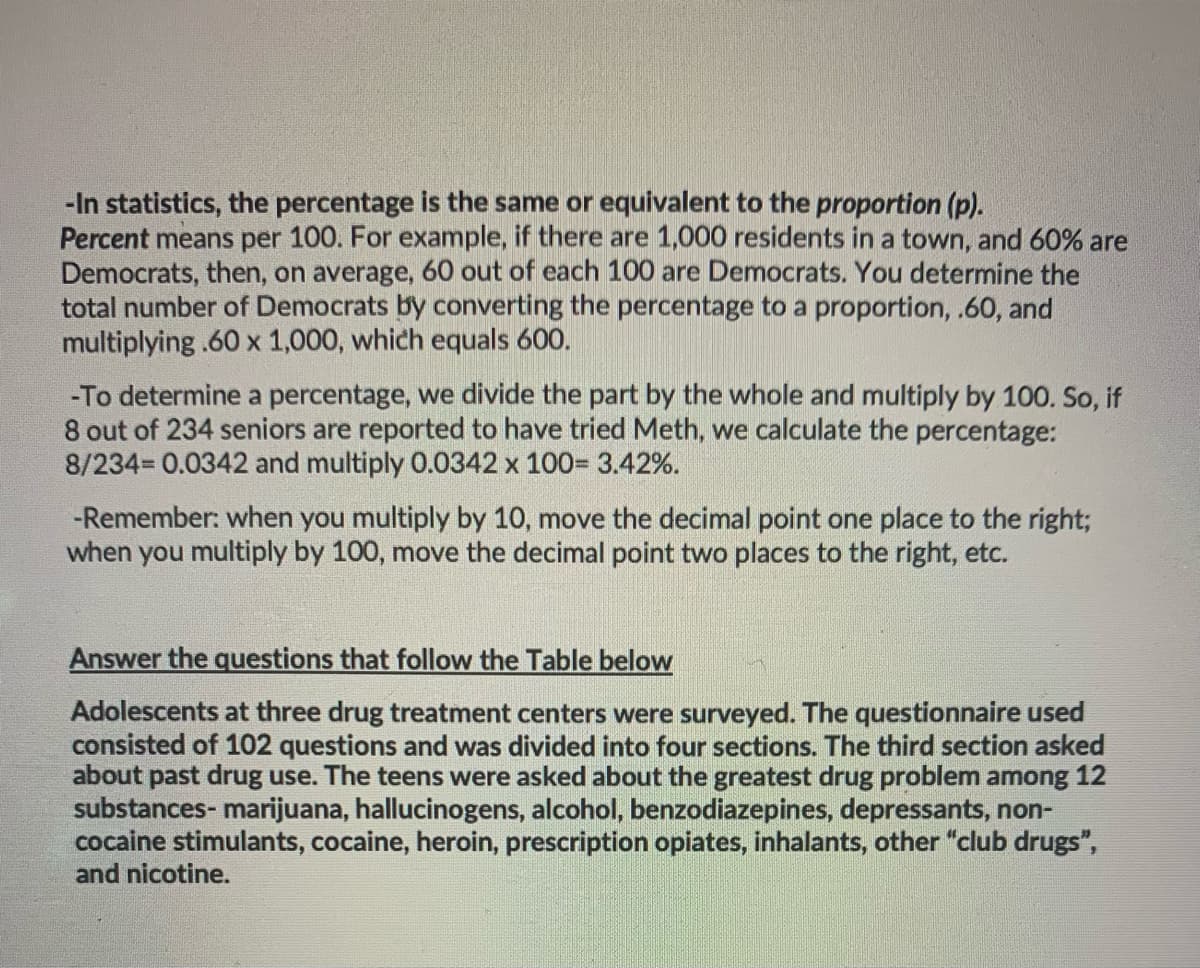Drug Use Characteristics of Adolescent Treatment Centers (N=181) Substance Greatest problem drug Lifetime Use Marijuana 65.7 99.4 Nicotine 11.0 81.8 Alcohol 6.1 94.5 Cocaine/crack 5.5 34.8 Club drugs 3.9 32.0 Heroin/illicit methadone 3.3 13.8 Hallucinogens 3.3 31.5 Benzos/depressants 1.2 31.5 Inhalants 9.4 Prescription opiates 25.4 3. Which substance has the highest percentage of lifetime users? 4. Expressed as a percentage, what was the difference between marijuana and nicotin as the greatest drug problem?
Drug Use Characteristics of Adolescent Treatment Centers (N=181) Substance Greatest problem drug Lifetime Use Marijuana 65.7 99.4 Nicotine 11.0 81.8 Alcohol 6.1 94.5 Cocaine/crack 5.5 34.8 Club drugs 3.9 32.0 Heroin/illicit methadone 3.3 13.8 Hallucinogens 3.3 31.5 Benzos/depressants 1.2 31.5 Inhalants 9.4 Prescription opiates 25.4 3. Which substance has the highest percentage of lifetime users? 4. Expressed as a percentage, what was the difference between marijuana and nicotin as the greatest drug problem?
Holt Mcdougal Larson Pre-algebra: Student Edition 2012
1st Edition
ISBN:9780547587776
Author:HOLT MCDOUGAL
Publisher:HOLT MCDOUGAL
Chapter11: Data Analysis And Probability
Section11.5: Interpreting Data
Problem 9E
Related questions
Question

Transcribed Image Text:Table
Drug Use Characteristics of Adolescent Treatment Centers (N=181)
Substance
Greatest problem drug Lifetime Use*
Marijuana
65.7
99.4
Nicotine
11.0
81.8
Alcohol
6.1
94.5
Cocaine/crack
5.5
34.8
Club drugs
3.9
32.0
Heroin/illicit methadone
3.3
13.8
Hallucinogens
3.3
31.5
Benzos/depressants
1.2
31.5
Inhalants
9.4
Prescription opiates
25.4
3. Which substance has the highest percentage of lifetime users?
4. Expressed as a percentage, what was the difference between marijuana and nicotine
as the greatest drug problem?

Transcribed Image Text:-In statistics, the percentage is the same or equivalent to the proportion (p).
Percent means per 100. For example, if there are 1,000 residents in a town, and 60% are
Democrats, then, on average, 60 out of each 100 are Democrats. You determine the
total number of Democrats by converting the percentage to a proportion, .60, and
multiplying .60 x 1,000, which equals 600.
-To determine a percentage, we divide the part by the whole and multiply by 100. So, if
8 out of 234 seniors are reported to have tried Meth, we calculate the percentage:
8/234 0.0342 and multiply 0.0342 x 100= 3.42%.
-Remember: when you multiply by 10, move the decimal point one place to the right3;
when you multiply by 100, move the decimal point two places to the right, etc.
Answer the questions that follow the Table below
Adolescents at three drug treatment centers were surveyed. The questionnaire used
consisted of 102 questions and was divided into four sections. The third section asked
about past drug use. The teens were asked about the greatest drug problem among 12
substances- marijuana, hallucinogens, alcohol, benzodiazepines, depressants, non-
cocaine stimulants, cocaine, heroin, prescription opiates, inhalants, other "club drugs",
and nicotine.
Expert Solution
This question has been solved!
Explore an expertly crafted, step-by-step solution for a thorough understanding of key concepts.
This is a popular solution!
Trending now
This is a popular solution!
Step by step
Solved in 3 steps with 1 images

Recommended textbooks for you

Holt Mcdougal Larson Pre-algebra: Student Edition…
Algebra
ISBN:
9780547587776
Author:
HOLT MCDOUGAL
Publisher:
HOLT MCDOUGAL


Glencoe Algebra 1, Student Edition, 9780079039897…
Algebra
ISBN:
9780079039897
Author:
Carter
Publisher:
McGraw Hill

Holt Mcdougal Larson Pre-algebra: Student Edition…
Algebra
ISBN:
9780547587776
Author:
HOLT MCDOUGAL
Publisher:
HOLT MCDOUGAL


Glencoe Algebra 1, Student Edition, 9780079039897…
Algebra
ISBN:
9780079039897
Author:
Carter
Publisher:
McGraw Hill

Functions and Change: A Modeling Approach to Coll…
Algebra
ISBN:
9781337111348
Author:
Bruce Crauder, Benny Evans, Alan Noell
Publisher:
Cengage Learning

Algebra: Structure And Method, Book 1
Algebra
ISBN:
9780395977224
Author:
Richard G. Brown, Mary P. Dolciani, Robert H. Sorgenfrey, William L. Cole
Publisher:
McDougal Littell

Big Ideas Math A Bridge To Success Algebra 1: Stu…
Algebra
ISBN:
9781680331141
Author:
HOUGHTON MIFFLIN HARCOURT
Publisher:
Houghton Mifflin Harcourt